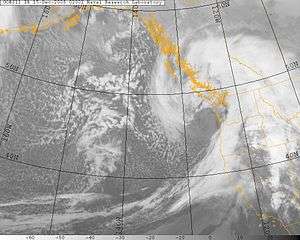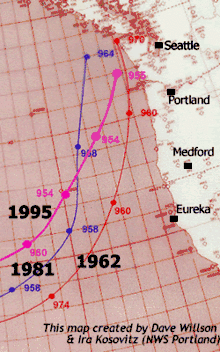Pacific Northwest windstorm
Pacific Northwest windstorms, sometimes colloquially known as Big Blows,[1] are extratropical cyclones which form in the Pacific basin, and affect land areas in the Pacific Northwest of the United States and British Columbia, Canada. They form as cyclonic windstorms associated with areas of low atmospheric pressure that track across the North Pacific Ocean towards western North America. Deep low pressure areas are relatively common over the North Pacific. They are most common in the winter months. On average, the month when most windstorms form is November or December.

Hanukkah Eve windstorm of 2006 off the Washington Coast on December 15, 2006 at 2:00 UTC.
The closest analogue to these storms are European windstorms, which develop over the eastern portion of the North Atlantic Ocean as opposed to the North Pacific.[2]
Categories and frequency

Storm tracks of the central low pressure of the storms which hit the Pacific Northwest in 1962, 1981 and 1995
| Average Peak Instant Gust (mph) | Windstorm Category | Approximate Return Interval |
|---|---|---|
| 39-44 | Minor | Several per year |
| 45-54 | Moderate | Annual |
| 55-64 | Major | Once every 2–3 years |
| 65-74 | Extreme | Once every 5–10 years |
| 75+ | Phenomenal | Once every 25–50 years |
Notable Pacific Northwest windstorms
- 1880: Great Gale of 1880
- 1921: January 29, the Great Olympic Blowdown.
- 1962: Columbus Day Storm began life as tropical storm Typhoon Frieda/Freda.
- 1979: February 13 windstorm leads to the catastrophic failure of the Hood Canal Bridge.
- 1981: Friday the 13th Windstorms, November 13–15[4]
- 1990: November 22–24, Mercer island bridge sinking Washington state[5]
- 1993: Inauguration Day windstorm, January 20. Claimed five lives, 750,000 homes and businesses without power with total damage in western Washington of $130 million.[6]
- 1995: December 11–12[7]
- 2002: South Valley Surprise of 2002
- 2006: Hannukah Eve windstorm[8]
- 2007: Great Coastal Gale of 2007
- 2013: Remnants of Typhoon Pabuk on September 28-29, 2013 caused heavy rain in Portland, Oregon had the wettest September ever on record.
- 2015: August 29–30 windstorm knocking out power to 710,000 customers in British Columbia's Lower Mainland region. Several municipalities in Metro Vancouver were without power for three days; at the time it was the largest outage in BC Hydro's recorded history.[9][10]
- 2016: Ides of October storm, Typhoon Sondga transitioned into an extratropical storm as it crossed the North Pacific and approached the west coast of North America. Originally, expected to be a historic windstorm to make a direct hit on Washington State, the worst of the storm ended up staying offshore. Despite this, coastal regions reported winds as high as 100 mph and an EF-2 tornado touched down in Manzanita.[11]
- 2018: December 20th, as winds approached (and occasionally exceeded) 100 km/h, trees came down, high seas cancelled ferries and over 750,000 customers in British Columbia lost power; causing the largest outage in BC Hydro's recorded history.[12] One man needed to be rescued by helicopter from the damaged White Rock Pier and a woman was killed in Duncan after being struck by a tree.[13]
- 2020: January 31st-February 1st, an intense low pressure system brought heavy rain to Metro Vancouver, Washington State and strong winds in the Fraser Valley and over 13,000 customers in British Columbia lost power.
References
- Knox, John A.; Frye, John D.; Durkee, Joshua D.; Fuhrmann, Christopher M. (2011). "Non-Convective High Winds Associated with Extratropical Cyclones". Geography Compass. 5 (2): 63–89. doi:10.1111/j.1749-8198.2010.00395.x. Retrieved April 16, 2013.
- Mass, Clifford; Dotson, Brigid (2010). "Major Extratropical Cyclones of the Northwest United States: Historical Review, Climatology, and Synoptic Environment". Monthly Weather Review. 138 (7): 2499–2527. Bibcode:2010MWRv..138.2499M. doi:10.1175/2010MWR3213.1.
- "Some Historical Weather Events in the Pacific Northwest". Office of Washington State Climatologist. Retrieved April 15, 2013.
- Read, Wolf. "Two Windstorms in Three Days November 13–15, 1981". The Storm King, hosted by the Office of Washington State Climatologist. Retrieved April 17, 2013.
- "Wind Storms". Office of Emergency Management, Seattle. Retrieved April 15, 2013.
- "Washington's Top 10 Weather Events of 1900s". National Weather Service, Portland Oregon. Retrieved April 17, 2013.
- Read, Wolf. "The Major West Coast Windstorm of December 12, 1995". The Storm King, hosted by the Office of Washington State Climatologist. Retrieved April 14, 2013.
- Read, Wolf. "December 14-15, 2006 Windstorm". The Storm King, hosted by the Office of Washington State Climatologist. Retrieved April 14, 2013.
- Pawson, Chad (August 29, 2015). "B.C. Lower Mainland storm cuts power to 400,000 homes". CBC News. Retrieved October 14, 2017.
- "B.C. storm: 'Largest outage event' in BC Hydro history". CBC News. September 1, 2015. Retrieved October 14, 2017.
- "The mid-October windstorm in the Pacific Northwest | NOAA Climate.gov". www.climate.gov. October 28, 2016. Retrieved November 1, 2016.
- "December storm 'most damaging' in BC Hydro's history, report says". CBC News. January 2, 2019. Retrieved June 29, 2019.
- "In pictures: Powerful December windstorm blasts B.C.'s south coast | Globalnews.ca". globalnews.ca. December 20, 2018. Retrieved February 24, 2019.
External links
This article is issued from Wikipedia. The text is licensed under Creative Commons - Attribution - Sharealike. Additional terms may apply for the media files.
